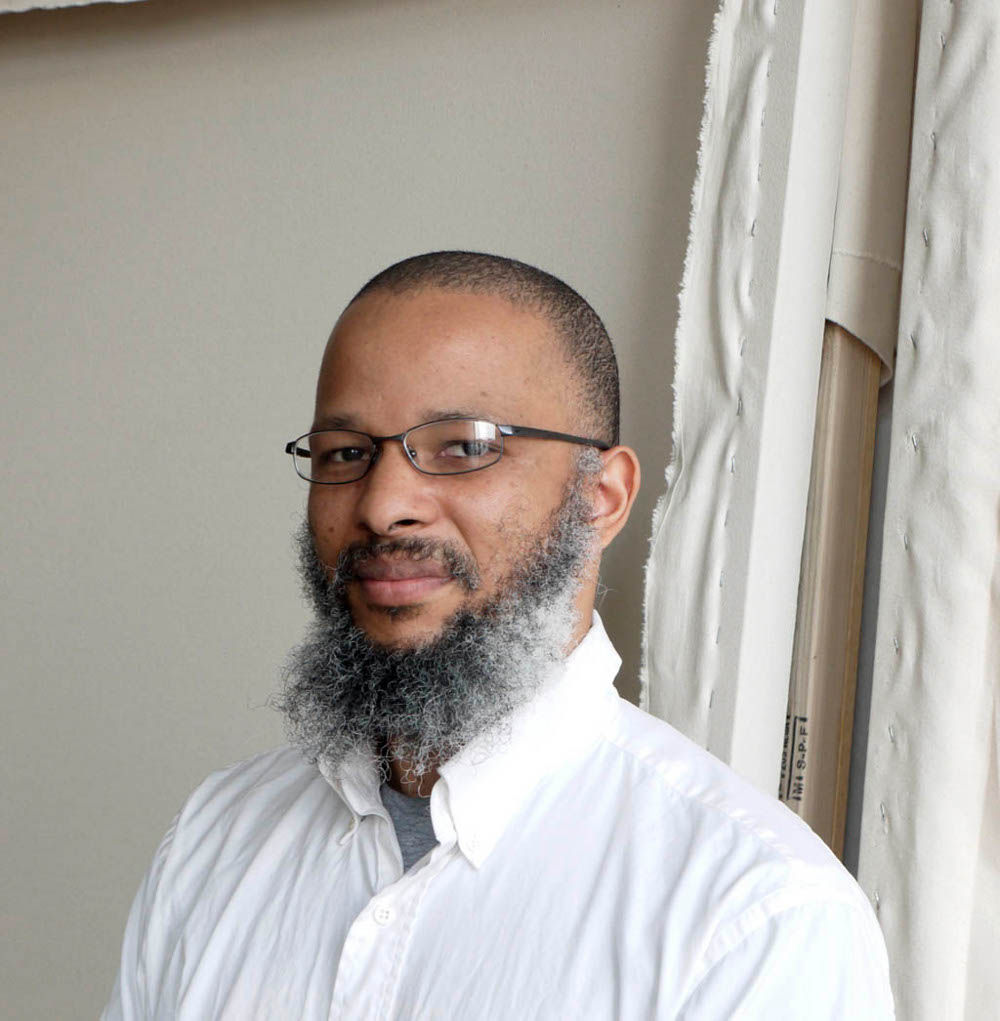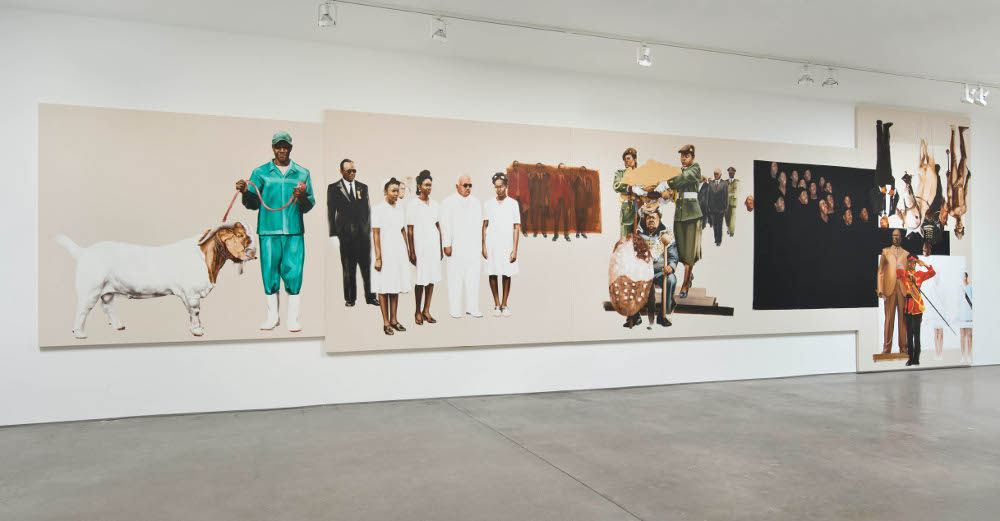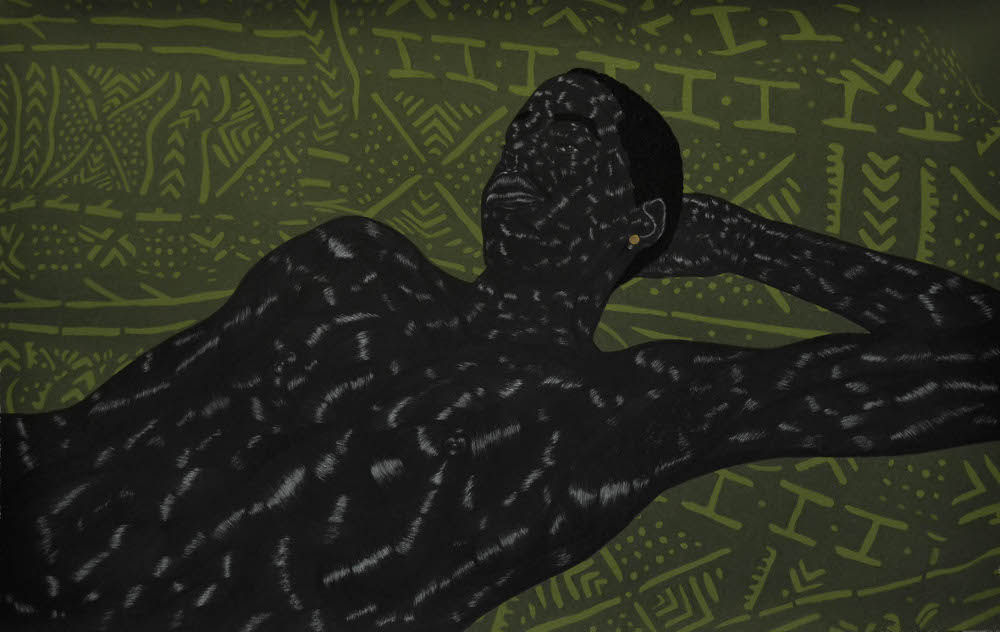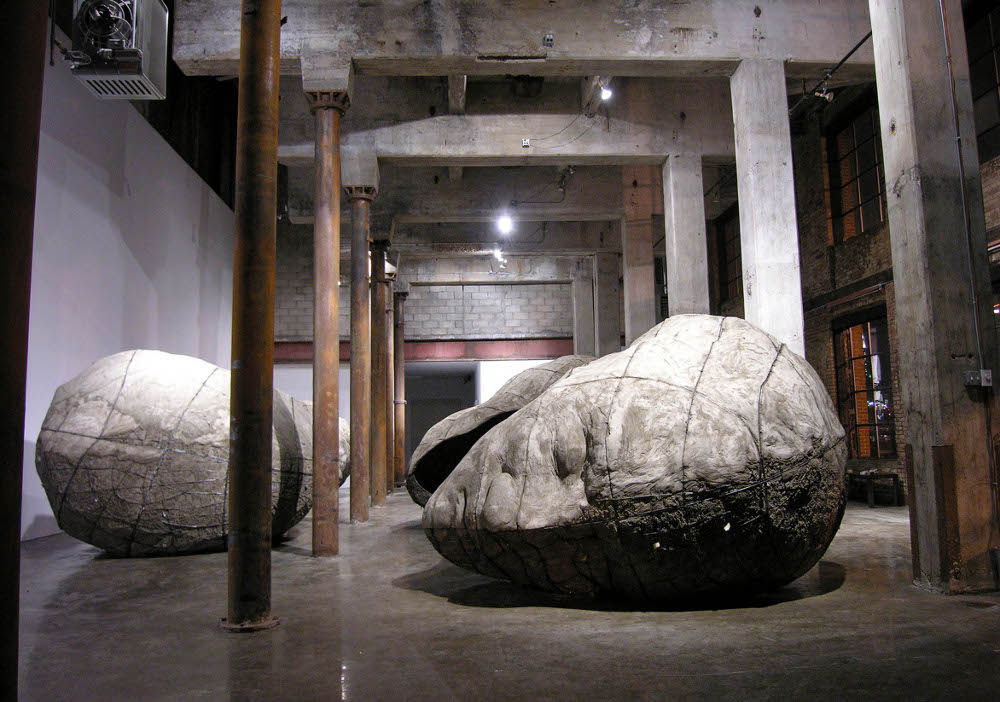Meleko Mokgosi has produced a series of huge paintings for his 'Pax Kaffraria' work
The image of a stout-shouldered Boer goat is mesmerising. A man dressed in a teal-green farmworker’s uniform, pant cuffs tucked into white gumboots, holds the animal on a leash, striking a showman’s pose. Two solid boerbuls look on – a large male stands protectively over a seated puppy.
In a second canvas, a pair of middle-aged women converse by an open window, a green chalkboard on one wall betraying the space as a classroom, while a louche martinet lounges in a chair gazing at a third image. We watch him watching several rows of schoolgirls, feet clad in black shoes and white socks, faces and uniformed torsos obscured by an over-painted black box. The visual obstruction is just transparent enough to discern a row of crossed arms and distinct faces – faces that are both exposed and negated by the filter of black paint.
These three enormous canvasses (the smallest measures just over 2m x 2m), hang edge to edge, constituting a stunning triptych titled Fully Belly II (2014). They are part of Meleko Mokgosi’s large-scale – in size, time line, and ambition – Pax Kaffraria series (2010-2014).
A couple of months after first seeing his work, I sit down to chat with Mokgosi at an organic brunch spot in the Lower East Side of New York. He’s a quiet man with a gentle face and a grey beard that makes me think he’s older than his 33 years. We chose not to meet at his Sunset Park studio where he works because, as he puts it: “It’s empty.”
Barely a week before our meeting, his first solo show with Honor Fraser Gallery in Los Angeles opened, and all of his most recent works – the final three suites of Pax Kaffraria – are on display.
Pax Kaffraria is a work comprising eight “chapters”; each including a number of works that constitute sub-chapters. Very broadly speaking, the theme of the work is a re-narrativisation of the history of Southern Africa, spanning Mokgosi’s home country of Botswana outwards into neighbouring Zambia, Zimbabwe, South Africa and Namibia. The images are characterised by a precise painting style, prominent blank canvas backgrounds, and distinct, almost mythologised figures ranging from day labourers and housekeepers to tribal chiefs and military generals. It’s a work that if shown in its entirety would engulf an institution. And that’s kind of the point.
Born and raised
Raised in the town of Maun in Botswana, Mokgosi attended high school in the capital, Gaborone, on a government scholarship. It was there that he started painting, encouraged by a supportive teacher. After high school he took an opportunity to study abroad, again on a scholarship, completing a BA in Studio Art at Williams College in Massachusetts in the United States in 2007.
But it was his participation in the independent study programme at the Whitney in New York in 2008/2009 that really pushed his budding career in its current epic direction.
“I was the youngest one there,” he says, “the least experienced.”

Botswana-born artist Meleko Mokgosi.
At Whitney he met artist Mary Kelly and the two formed a bond – Mokgosi completed a masters in fine arts at the University of California, Los Angeles, under her mentorship. Kelly’s influence is clear: she works in large-scale, narrative installations. But that’s where the similarity ends. Kelly’s images are delicate, and she is best known for works made of compressed drying-machine lint.
Mokgosi is a rare breed in today’s art world – a pure painter. His work is grounded in classical training, both in terms of technique – his early influences include Caravaggio and Vermeer – and in his approach to the theories of art history.
Unlearning how to paint
Over the course of the Whitney residency Mokgosi came into his own. “That was when a practice became a practice,” he tells me. “At Whitney I unlearned how to paint.” This unlearning started at the most basic first steps of the painting process.
“When you paint, you stretch a canvas first and then you prime it in white,” Mokgosi explains. “The art world takes this white background for granted.” So after stretching his canvasses Mokgosi instead primes them with a clear coat. Even this seemingly neutral first-step is minutely considered. In Mokgosi’s work everything is accounted for. The clear primer also means he cannot over-paint in order to correct his errors. The canvas registers all marks; there are no mistakes.
“Everything happening on the canvas is because it needs to be there,” says Mokgosi. “There are no improvisations. I have 80% of an idea of how it will look before I start,” he says. Before putting down a single mark on the canvas, Mokgosi storyboards the work on 11×14-inch paper, in pencil. In the case of Pax Kaffraria the title came first followed by the sub-titles, which he then organised into eight chapters.
Each canvas in each chapter is carefully planned, right down to the brush size and the tone and colour of paint used to create each mark. Images are researched. Source material includes photographs and images taken from newspapers and magazines – most recently farmers’ digests and wedding periodicals – as well as on-site research.
Mokgosi travels back to Botswana as frequently as he can. Given this exhaustive process, he can take between two and five months to storyboard a work. Mokgosi’s practice speaks to one of the foundational structures behind his art: in the discourse of post-colonialism, decolonisation, or globalisation, the mode of production has to be accounted for.
“Production is a political question,” he says, “and the gallery absorbs it. Artists no longer think about the politics of production, about the socioeconomic conditions they are reproducing.”
Negating history
For Mokgosi, painting – as an act, object and commodity – is always political. “You have to know the history to painting,” he tells me, “but you also have to know how to negate that history.”
This principle grounds his practice in a deep well of art and literary theory, to say nothing of art history. “I was colonised very well,” he says with a laugh. He namedrops post-modernist theorist Craig Owens, the Greenbergian formalist Rosalind Krauss and feminist artist Barbara Krueger, but one can also sense the Frankfurt School at work.
“Painting is part of the discourse of post-colonialism and materialism,” Mokgosi tells me. “And these questions [of what history and narrative are] must be articulated in the medium. This is the aesthetic of how I approach painting.”

Paintings from Meleko Mokgosi’s ‘Pax Kaffraria’ .
At its core, the Pax Kaffraria series considers the creation of capital “H” History and the ways in which societies produce narratives. The title brings together two terms: “pax”, a Latin term referring to a period of peace, usually imposed by a predominant nation; and “Kaffraria”, a British term used in the 18th century to refer to what is now the southeast part of the Eastern Cape of South Africa, a territory primarily inhabited by the Xhosa.
The imagery is drawn from the histories of Southern Africa, transmogrified under artist’s deft brush as questions of nationhood, colonialism, history and post-colonial aesthetics.
Complex and brutal
Mokgosi’s histories are complex and often brutal, even if his canvasses are gorgeously precise.
The chapter titled Sikhuselo Sembumbulu (2012) is derived from a Xhosa term meaning “bulletproof”. It’s a reference to the Xhosa cattle killings of 1856–57, which were intended to drive away the colonial powers and simultaneously resurrect the ancestors. The work includes images of slaughtered cows, a priest, schoolchildren, uniformed men, domestic workers and a couple dancing, arranged on canvasses that touch and images that occasionally overlap.
His depiction of the event is not a conventional narrative; he is not documenting a specific series of historical events. Instead, his stories take shape image by image, all of which form a narrative through association and juxtaposition.
“The question I’m asking is ‘what is narrative?’ and the answer is that nothing can be reconciled, it is always going to be messy,” he says. He references the Zakes Mda novel A Heart of Redness alongside an academic text, Bulletproof: Afterlives of Anticolonial Prophesy in Africa and Beyond by Jennifer Wenzel.
“I’m interested in the way the Xhosa used failure as a way to succeed,” he says. “We are going to lose in order to win … It was their only response to colonial power. It was their form of resistance.”
Two abiding concerns
The title Pax Kaffraria points to two abiding concerns: the nation and its influence on historical creation, and the mythologies and assumptions associated with “Africa”. In his careful painting technique, he parses the way history is constructed and transmitted. And although they are aesthetically stunning, the works demand close, intelligent reading to grasp their intentions.
Critics have described Mokgosi’s work as cinematic, no doubt a reference to the storyboards as well as the large scale of the works and the vivid imagery. The viewer is confronted with bold visuals on stark backgrounds. The dogs, goats and cattle are rendered with gleaming musculature; the figures are crisp in the details of dress and expression.
But this realism is tempered by a spatial unfinishedness. Figures often float in space, suspended in the matrix of the canvas, asking the viewer to work to understand their interrelations and meanings, challenging any simple reading.
As Yael Lipschutz wrote in an Art in America review of Mokgosi’s works in the Made in LA Show at the Hammer Museum in 2012: “Like social commentators of the past such as Larry Rivers and Leon Golub, who worked in a similarly open and unfinished tradition, Mokgosi channels his painterly ‘pauses’ to allow us Westerners a psychic entry point into stories that may seem out of reach if handled differently.”
Finding a home in a commercial gallery is a challenge for many artists; it’s even more challenging when your work is as specific in its needs as Mokgosi’s. Honor Fraser Gallery in Los Angeles has represented Mokgosi for nearly three years, but this past May was his first solo show.
Broad spectrum of artists
The Los Angeles-based gallery boasts a broad spectrum of artists, from conceptual to abstract to realist, but what binds them, says artist liaison Corrina Peipon, is quality: “It’s the artist’s commitment to their own projects. They are uncompromising in their work.”
Uncompromising is a good word to describe Mokgosi. Each show is a careful negotiation of how he wants his painting installation to be read, and due to the size and number of large canvases, spaces tend towards the gargantuan. Past exhibitions have included the Lyon Biennale (Lyon, France), the Yerba Buena Centre for Arts in San Francisco and the Hammer Museum in Los Angeles.
His approach to subject matter is also uncompromising. He is dealing with a complex history, one that continues to be narrated from a number of often conflicting perspectives.
“Cultural interrogation and literary criticism are what drive Meleko’s work,” Peipon tells me. “The overall project is looking at something much more broad, at cultural biases and how the biases we hold often affect how we see history.”
When asked if the gallery considers Mokgosi an “African” artist, Peipon replies: “We take our cue from Meleko. It’s strong work. The content and the form are inextricable, and the content is related to Southern Africa. Meleko feels very strongly, as do we, that the work is very much about narrative and how it helps us construct history, for better or for worse.”
The completion of the last chapter raises an important question: are there any plans afoot in presenting all eight chapters of Pax Kaffraria together, for the very first time? Peipon defers: “All I can say is that ideally this work would be seen in its entirety.” Such a show would be a seminal moment in this incredible artist’s career. Something to think about, South African art world movers and shakers.
African-born artists on the rise
African-born artists are making their mark on the international arts scene. Here are a few to watch:
Toyin Odutola
Born in Ife, Nigeria, Toyin Odutola is a young artist who is fast establishing herself on the international art scene. Living and working in New York, she currently shows with Jack Shainman Gallery (New York) and has works in institutional collections, including the Smithsonian. Odutola’s portraits and drawings are composed using ballpoint pens and Sharpie markers, and are both hyperrealistic and abstract. She is active on social media, often discussing her process with her many followers on Instagram, Twitter and Tumblr. www.toyinodutola.com

Carla Liesching
Hailing from Cape Town and raised in the Eastern Cape, Liesching now lives and works in New York. A photographer and multimedia artist, her work examines human relationships to structure, in particular ideological shifts in geographic narratives. She is represented by Cape Town gallery Brundyn+Gonsalves and her most recent work includes a series of staged environmental portraits.
www.carlaliesching.com/
Robin Rhode
This Cape Town-born, Berlin-based artist is known for an interdisciplinary approach in his work. Educated in filmmaking as well as fine arts, his earlier works involved creating performances based on his own drawings, a practice that has evolved to include photography sequences and digital animations. Rhode visits South Africa often, working in the streets of Jo’burg. Represented by Lehmann Maupin (New York) and White Cube (London), he is an international artist on the move.
www.lehmannmaupin.com/artists/robin-rhode
Julie Mehretu
Julie Mehretu is an abstract artist born in Addis Ababa, Ethiopia, who lives and works in New York. Her large-scale architecturally inspired paintings and drawings are made using a layering technique and she often mixes media – acrylic paint on canvas overlaid with pencil, pen, ink and paint, for example. Represented by Marian Goodman (New York) her works are exhibited and collected internationally, most recently at Documenta (13).
www.mariangoodman.com/artists/julie-mehretu
Ledelle Moe
This Durban-born South African sculptor has lived and worked in Baltimore, Maryland, in the United States since 1994, teaching at the Maryland Institute College of Art. Moe’s large-scale concrete and steel sculptures of human and animal figures, often exploring the relationship between form and decay, have recently been exhibited in Brooklyn, New York; Salzburg, Austria; and at the Nirox Foundation Sculpture Park in Johannesburg. After over 20 years abroad Moe recently relocated to Cape Town, so look for more of her work on display in South Africa soon.
www.ledellemoe.com
